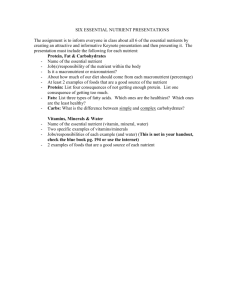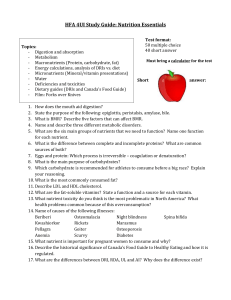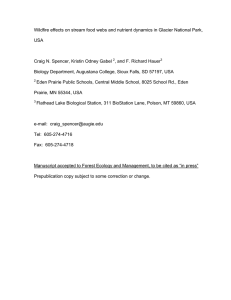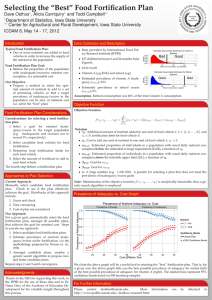A Genetic Algorithm Approach to Optimize Planning of Food Fortification
advertisement
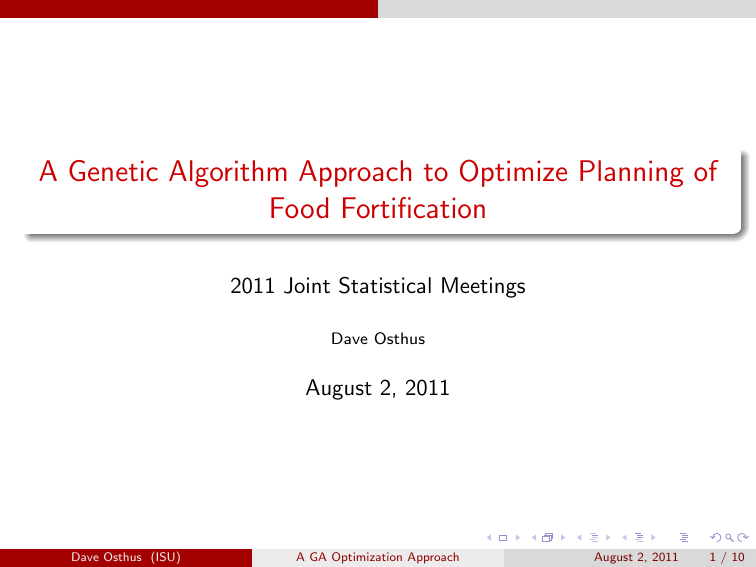
A Genetic Algorithm Approach to Optimize Planning of
Food Fortification
2011 Joint Statistical Meetings
Dave Osthus
August 2, 2011
Dave Osthus (ISU)
A GA Optimization Approach
August 2, 2011
1 / 10
Outline
1
Nutrition Background
2
Food Fortification Background
3
Optimal Fortification Planning Approach
4
Genetic Algorithms
5
Results via an Example
Dave Osthus (ISU)
A GA Optimization Approach
August 2, 2011
2 / 10
Nutrition Background
Usual Daily Nutrient Intake
Usual Daily Nutrient Intake: The long run average of daily nutrient
consumption.
Reliable estimation of usual daily nutrient intake distributions has
been thoroughly explored (National Research Council, 1986; Nusser
et. al., 1996)
Usual Daily Intake Distribution
0.0030
Usual daily nutrient intake distributions
are used to:
2
Identify populations with nutrient
inadequacies.
Develop programs to combat these
inadequacies.
0.0020
density
1
0.0025
0.0015
0.0010
0.0005
0.0000
500
1000
1500
Usual Daily Nutrient Intake
Dave Osthus (ISU)
A GA Optimization Approach
August 2, 2011
3 / 10
Nutrition Background
Identification of Nutrient Inadequacies
Prevalence of nutrient inadequacy (αPoI ∈ [0, 1]): Estimated as
the proportion of individuals in a population with usual daily nutrient
consumption below the Estimated Average Requirement (EAR).
EAR: Daily nutrient intake level that is estimated to meet the needs of
half the healthy individuals in a specified age and gender population.
Prevalence of nutrient excess (αPoE ∈ [0, 1]): Estimated as the
proportion of individuals in a population with usual daily nutrient
consumption above the Tolerable Upper Limit (UL).
UL: Highest level of nutrient consumption regarded as safe for
individuals in a specified age and gender population.
Usual Daily Intake Distribution
0.0030
0.0025
density
0.0020
0.0015
0.0010
0.0005
0.0000
200
400
600
800
1000
1200
Usual Daily Nutrient Intake
Dave Osthus (ISU)
A GA Optimization Approach
August 2, 2011
4 / 10
Food Fortification Background
Development of Programs to Combat Nutrient
Inadequacies
Prevalence of nutrient inadequacy and/or excess goals are set
(βPoI ∈ [0, 1] and βPoE ∈ [0, 1], respectively).
Food Fortification Plan: An intervention where specific amounts of
nutrient are added to specific food vehicles.
Candidate food vehicles and fortification limits are selected and set by
food scientist.
In practice, if the fortification plan results in αPoI ≈ βPoI and/or
αPoE ≈ βPoE and the cost is reasonable, then the plan is considered
successful.
Main Question: How do we identify the “best” fortification
plan?
“Best” plan is the fortification plan that meets the prevalence of
inadequacy/excess goals for minimal cost.
Dave Osthus (ISU)
A GA Optimization Approach
August 2, 2011
5 / 10
Optimal Fortification Planning Approach
Optimization Function
Notation
γk : Additional amount of nutrient added to one unit of food vehicle
k, k ∈ {1, 2, . . . , K } and γk ∈ [0, fortification limit for food vehicle k].
ck : Cost to add one unit of nutrient to one unit of food vehicle k,
ck ≥ 0.
λ: A large number (e.g. 1,000,000). A penalty for selecting a plan
that does not meet the prevalence of inadequacy/excess goals.
Optimization Function
f (γ1 , γ2 , . . . , γK ) =
PK
k=1 (ck
∗ γk ) + λ[|αPoI − βPoI | + |αPoE − βPoE |]
Note
∂f
∂γk (γ1 , γ2 , . . . , γK )
is not analytically tractable. Numerical
optimization method utilized.
Dave Osthus (ISU)
A GA Optimization Approach
August 2, 2011
6 / 10
Genetic Algorithm
Genetic Algorithm
A genetic algorithm is a stochastic optimization algorithm that
attempts to mimic the evolutionary process as demonstrated in nature
by biological individuals.
Few restrictions.
Results get better as run time increases.
Dave Osthus (ISU)
A GA Optimization Approach
August 2, 2011
7 / 10
Prevalence of Adequacy v. Cost Graph
Prevalence of Adequacy v. Cost Graph
Data: Ugandan children between 6 and 24 months of age.
Nutrient: Vitamin A
Food Vehicles: Sugar, Vegetable Oil, Wheat Flour and Maize Flour
Pre-fortification: αPoI = 0.93 and αPoE = 0.00
Prevalence of Nutrient Adequacy vs. Cost
Prevalence of Excess
Usual Nutrient Intake of Vitamin A using ISU Method
Prevalence of Inadequacy
1.0
0.005
Prevalence of Nutrient Adequacy
0.8
density
0.004
0.003
0.002
0.001
Nutrient
1 − PoI
0.6
1 − PoE
Confidence_Bands
Actual Data
0.4
95% Confidence Bands
0.2
0.000
0
200
400
600
800
Vitamin A Consumption (µg RAE/day)
Dave Osthus (ISU)
1000
20
25
30
35
20
25
30
35
Cost ($/MT)
A GA Optimization Approach
August 2, 2011
8 / 10
Special Thanks To:
Dr. Alicia Carriquiry
Todd Campbell
Dr. Omar Dary
Dave Osthus (ISU)
A GA Optimization Approach
August 2, 2011
9 / 10
Questions?
(dosthus@iastate.edu)
Dave Osthus (ISU)
A GA Optimization Approach
August 2, 2011
10 / 10

